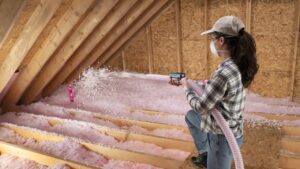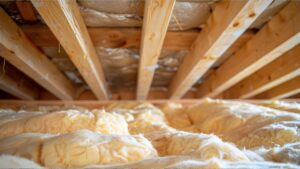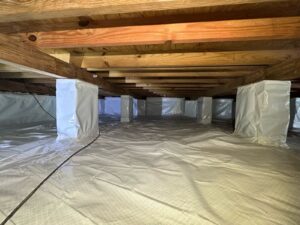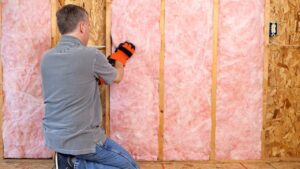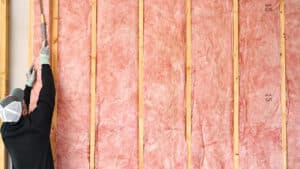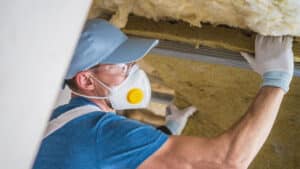One of the biggest worries for a homeowner is rodents getting into their home. When an infestation begins, getting the rodents out of your house is the first thought that comes to mind. What occurs next, though? In addition to getting rid of the rats, you’ll want your house thoroughly cleaned and sanitized. Your insulation is one area that needs maintenance following an infestation. Removing a certain kind of rodent infestation is necessary.
Continue reading for a breakdown of the method and hazards from the Universal Insulation Doctor.
Do Rodents Eat Insulation?
Rodents can chew through wires, cardboard, wood, and insulation. They certainly do not need our leftovers, but what do they do with the garbage they find?
These fast-moving, microscopic pests may occasionally eat a small bit, but their preferred method of attack is to dig and tunnel through it. Rodents typically use insulation when building their nests for added softness and warmth.
Rodents are extremely dangerous due to their sharp fangs and claws. In addition to potentially threatening human health, this pest may wreak havoc on a home’s insulation, leading to condensation and drafts.
Reasons to Remove Insulation After a Rodent Infestation
You might assume the situation is fixed if you have hired a pest control service to eliminate mice or rats in your home. However, you still have some work to do.
We recommend replacing any insulation that may be present in your home. Any issues could have been left behind by the mice or rats that made your home their home. Putting aside the environmental benefits, why should you remove the old insulation now?
Replace the Damaged Insulation
homes and roofs are popular with rodents like mice and rats because they provide a warm, dry, and relatively quiet environment. They would benefit from any acoustic or thermal barrier that might be there. They can harm your drywall, insulation, and belongings the longer they stay in your home.
To create nests, rats can be known to rip off insulation sections and chew through them, leaving behind lumps and holes. Mice will often excavate a nesting area out of the insulation. They also dig underground shelters and escape routes out of the stuff.
If insulation is harmed, its ability to retain heat is diminished. If rodents have torn, chewed, or dug their way through your home’s insulation, your home’s temperature regulation is compromised. There will be a decline in the insulation’s effectiveness. Restoring this efficiency requires tearing out the old components and replacing them with new ones.
Minimize Health Risk
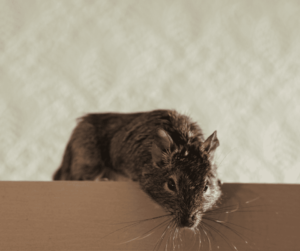 Rats and mice are notorious for spreading various diseases that can have serious consequences for humans. Some diseases they can transmit are Hantavirus, Salmonella, and Lymphocytic Choriomeningitis. Their waste and urine are common vectors for spreading disease, but this contamination can also be found in common household dust.
Rats and mice are notorious for spreading various diseases that can have serious consequences for humans. Some diseases they can transmit are Hantavirus, Salmonella, and Lymphocytic Choriomeningitis. Their waste and urine are common vectors for spreading disease, but this contamination can also be found in common household dust.
You can find rodent droppings and urine in the insulation if they have been there for some time. Removing these impurities while leaving the insulation as it is is impossible. They can be carried through the air in the dust even if no one touches them. Toxins in the air might be a serious issue for those who are sensitive to them.
You should remove the insulation if it poses a threat to human health. After that, you may feel good about spending time in your home again.
Remove Odd Smells
If rodents like rats or mice have gotten into your home and defecated or urined on your roof insulation, the air quality up there will likely deteriorate. If urine and droppings have seeped into the fabric, the odor is unlikely to disappear. Depending on the severity and duration of your infestation, the stench may spread to adjacent rooms.
You can only remove the scent by removing the source materials. After the old insulation has been removed and the area has been cleaned, you will notice a significant improvement in your home’s odor.
Check for Other Damage
Rats and mice cause problems for homeowners in more than simply the home. And they may wreak havoc on wooden structures and roofing shingles too. They can stretch openings and even eat through wires to gain entry.
If a rodent has chewed through an electrical wire, there is a serious risk to public safety. However, you may not notice the damage if the insulation is too thick. After removing the insulation, you can inspect the space for any damage and restore it to a safe condition.
Once you’ve eliminated the rodents from your home, you can look into how they got in. Intruder rodents can be tracked down, repaired, and blocked. A future colony of mice or rats will have a harder time re-establishing itself in the space. The old insulation will have to be removed before you can put in the new insulation.
Insulation Removals is the company to call if you need to remove insulation because of a pest problem. We can remove unwanted items promptly, securely, and effectively. Next, we can replace your old insulation with brand-new materials.
Keeping the Rodents out of the Insulation
It takes a professional approach to successfully exclude rodents from insulation.
Exclusion systems and crack and opening sealing can assist in permanently excluding rodents inside your home.
Rodents tend to congregate in areas where mouse urine has been left behind. It has been discovered that male mice use a protein in their urine to scent-mark their territory, which can entice other mice to move in. It emphasizes the significance of thorough rodent control and cleanup following an infestation.
It would be nearly hard to eliminate mouse droppings from your home without removing the insulation from the afflicted region. Universal Insulation Doctor will clear the area of all existing insulation, disinfect it, blow in new cellulose insulation, and remove any debris. The process can take some time to guarantee that all rodents have departed the area and that all toxins have been properly cleansed. To complete the process, you need to allocate two working days.


